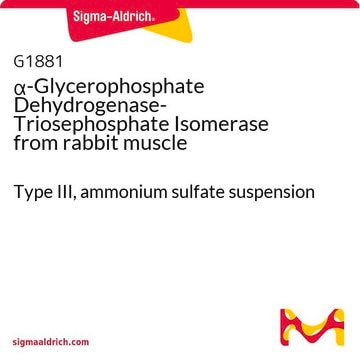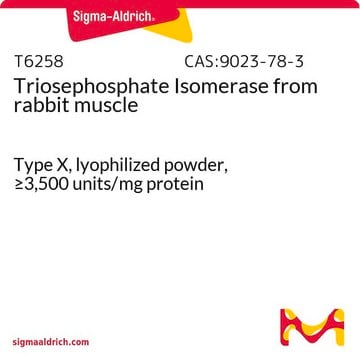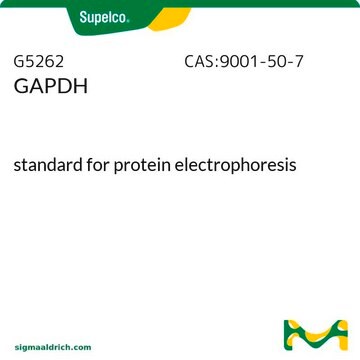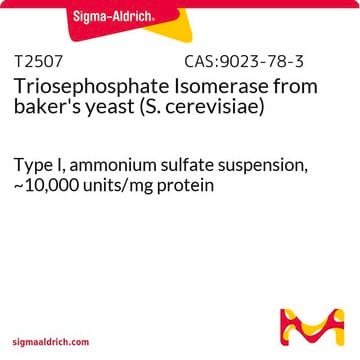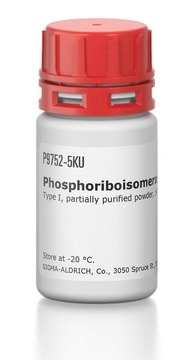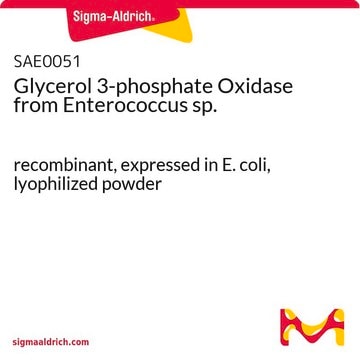P7634
3-Phosphoglyceric Phosphokinase from baker′s yeast (S. cerevisiae)
ammonium sulfate suspension, ≥500 units/mg protein
Sinónimos:
PGK, Phosphoglycerate kinase, 3-Phosphoglycerate kinase, ATP:3-Phospho-D-glycerate 1-phosphotransferase
About This Item
Productos recomendados
origen biológico
bakers yeast
Formulario
ammonium sulfate suspension
actividad específica
≥500 units/mg protein
condiciones de almacenamiento
(Tightly closed)
concentración
1.0-10.0 mg/mL
actividad extraña
Glyceraldehyde-3-phosphate dehydrogenase ≤0.1%
Condiciones de envío
wet ice
temp. de almacenamiento
2-8°C
¿Está buscando productos similares? Visita Guía de comparación de productos
Descripción general
Phosphoglycerate kinase (PGK), a glycolytic enzyme, is isolated from a broad variety of organisms. This typical hinge-bending monomeric enzyme is well-conserved among the three domains of life. The enzyme is made up of a single folded polypeptide chain that divides into two nearly identical domains, each linked by two -helices (-helices 7 and 14) and separated by a deep cleft. This arrangement gives the enzyme its distinctive bilobed structure.
Aplicación
- to study low molecular weight GTP-binding proteins and mechanisms of inhibition of glyceraldehyde-3-phosphate dehydrogenase
- in the coupled assay to measure the backward activity of purified rabbit skeletal muscle nicotinamide adenine dinucleotide (NAD+)-dependent glyceraldehyde3-phosphate dehydrogenase (GAPDH)
- in the assay of glyceraldehyde-3-phosphate dehydrogenase
Acciones bioquímicas o fisiológicas
Definición de unidad
Forma física
Nota de análisis
Producto relacionado
Palabra de señalización
Warning
Frases de peligro
Consejos de prudencia
Clasificaciones de peligro
Eye Irrit. 2
Código de clase de almacenamiento
12 - Non Combustible Liquids
Clase de riesgo para el agua (WGK)
WGK 2
Punto de inflamabilidad (°F)
Not applicable
Punto de inflamabilidad (°C)
Not applicable
Equipo de protección personal
Eyeshields, Gloves, type N95 (US)
Elija entre una de las versiones más recientes:
Certificados de análisis (COA)
¿No ve la versión correcta?
Si necesita una versión concreta, puede buscar un certificado específico por el número de lote.
¿Ya tiene este producto?
Encuentre la documentación para los productos que ha comprado recientemente en la Biblioteca de documentos.
Los clientes también vieron
Artículos
Instructions for working with enzymes supplied as ammonium sulfate suspensions
Nuestro equipo de científicos tiene experiencia en todas las áreas de investigación: Ciencias de la vida, Ciencia de los materiales, Síntesis química, Cromatografía, Analítica y muchas otras.
Póngase en contacto con el Servicio técnico

